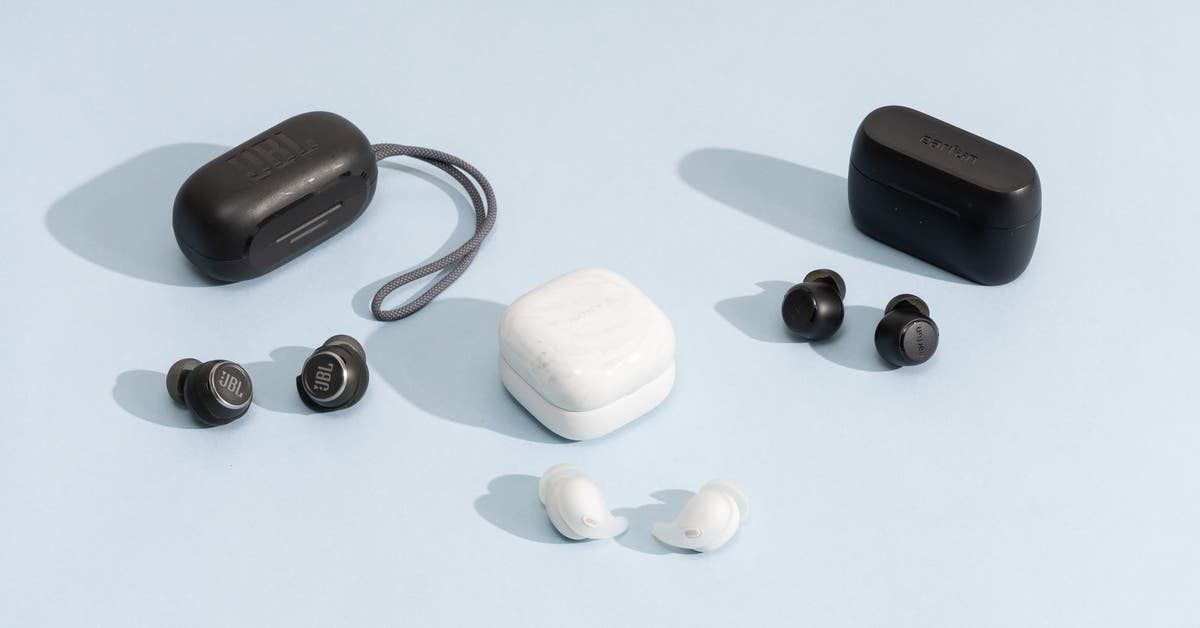The 3 Best Wireless Bluetooth Earbuds of 2025
We’ve tested more than 450 sets of Bluetooth earbuds to date, so we can’t list every competitor here. Below we discuss some of the newer and more-high-profile earbuds we’ve tested, but we also keep a running list of previously tested earbuds.
Out of the box, the 1More S70 open-ear pair had an off-putting, burnt-plastic smell that fortunately dissipated over time. Despite having six EQ settings (one of which is labeled “bass booster”), this pair delivered only a small amount of bass and made male vocals sound unnatural. The fit was comfortable, but we concluded that this design wasn’t special enough to warrant the original $120 price.
The ultra-affordable 1More Q10 true wireless earbuds have an unsealed, AirPods-like design, and the price is so low that the flaws are easier to overlook. The highs were a touch tizzy, but this set had more bass than many more-expensive unsealed pairs. The controls are limited, and the microphone quality is unremarkable yet functional. On the plus side, this set has an IPX4 water-resistance rating, and it offers around seven to eight hours of battery life per charge. The Q10 pair is a solid choice if you want the AirPods design on a budget.
We tested the AirPods 4 and AirPods 4 with Active Noise Cancellation. If you can’t stand the feeling of sealed earbuds and want some noise cancellation, the ANC pair is the only option out there. For everyone else, we think you can get better performance from our picks. Read more of our thoughts.
The controls on the Audio-Technica ATH-TWX7 are limited, the noise cancelling is mild, and the bass is either significantly reduced or smeared and muffled, depending on which sound mode you choose.
The Baseus Bowie 30 earbuds come with a massive charging case, and both the case and the earbuds are made of brittle-feeling plastic. The active noise cancellation is decently effective on low frequencies, but it will affect people who are prone to eardrum suck. The app provides adjustment to the ANC’s “depth,” but moving the fader didn’t change the intensity. The tap-based controls are adjustable but limited in capabilities, and we found them to be incredibly unreliable.
The Beats Fit Pro is a former pick that is growing long in the tooth. This pair sounds great, and we like the use of physical buttons instead of touch controls. However, this pair’s voice activation is only Apple-compatible, whereas the voice controls for the Sony LinkBuds Fit earbuds work with any OS. They are also more comfortable, with a cushy wing to hold them in place.
If you’re looking specifically for Apple-friendly workout earbuds, the Beats Powerbeats Pro 2 is a pricey but solid choice. This larger pair hooks over the ears instead of relying on wings like the JBL Reflect Aero TWS does, and it has a built-in heart-rate monitor that works well. The battery life of eight to 10 hours is good, and we liked how these earbuds sounded: They have ample bass with a slight emphasis on the highs to ensure clear vocals. However, that extra high-frequency boost might sound artificially hyped to sensitive ears, and there’s no way to EQ this pair. The hear-through mode is equally sibilant. Overall, we prefer the JBL pair’s lower price and higher IP rating for workouts, and for people who want to stay in the Apple ecosystem, the AirPods Pro 2 earbuds have more effective ANC and more bonus features. If you’d like to read more about how this pair compares to other workout earbuds for the gym, check out our guide to the best workout earbuds and headphones.
The Beats Studio Buds + is a solid pair of earbuds overall and shares a lot of iOS-friendly features with the Beats Fit Pro. We like the Fit Pro earbuds better because they’re more secure in the ears, they offer better noise cancellation, and their button design is more ergonomic, and we like the Sony LinkBuds Fit even more because of the set’s versatility and comfort.
The tiny case is the most unique part of the Beats Solo Buds. No transparency mode, no noise cancellation, limited controls, and no water resistance.
The Bose QuietComfort Earbuds are large, so the majority of our panelists found them uncomfortable. Plus, the noise cancellation didn’t measure as well as earbuds that cost a lot less, and the microphones were buggy when used in busy locations.
The Bose QuietComfort Ultra Earbuds are excellent at reducing noise, but the way the reduction functions can cause a lot of eardrum suck. You can read more in our guide to noise-cancelling headphones.
The cuff-like design of the Bose Ultra Open Earbuds is surprisingly comfortable. However, the microphone quality of this unsealed pair is incredibly disappointing. You can read more about these earbuds in our guide to the best running headphones.
Although the Cambridge Audio Melomania M100 pair sounds quite good (with some EQ tinkering in the app) and offers comedian Matt Berry as an optional menu voice, the ANC is mild, the hear-through mode has a stuffed-up quality, and the case is bigger than average. The earbuds are also thick and lack stabilizing wings, so smaller ears may find these tough to keep in place. We enjoyed listening to them, but if ANC is a priority or you have smaller ears, these aren’t for you.
The EarFun Air 2 earbuds are solid for the low price. With some EQ fussing, we found a sound we enjoyed, and the controls are easy to use. We prefer the design of our budget pick, but if it’s out of stock or you prefer the stem-style design, this is a solid choice.
Unfortunately, the EarFun Air 2 NC pair was less successful than the non-noise-cancelling set. The tap controls were very buggy, the hear-through mode sounded stuffy-headed, and we encountered some pairing issues in our test pair.
The EarFun Air Pro 4 is our budget pick for best noise-cancelling earbuds. We like this pair a lot, but it usually costs around $30 more than the EarFun Free 2. Unless noise cancellation is a priority for you, our budget pick is the better economical option.
The Jabra Elite 10 Gen 2 is a solid pair for the office. This pair sounds good, features dual-device connectivity, has clear mics for calls, and is one of the most comfortable sets of earbuds we’ve tested. The case that doubles as a Bluetooth transmitter is handy, the IP57 dust- and water-resistance rating is excellent, and we like the easy-to-press physical buttons. However, this pair is pricey, the noise cancellation isn’t competitive with that of the best options, and we are unsure what support will look like as Jabra exits the earbud market.
JBL’s Live Beam 3 is a good set of earbuds with solid but not superlative ANC performance. The buds themselves are on the chunky side, which could create a fit issue for people with smaller ears or a shallow concha. The thing that sets them apart is the smart case, which provides the features that you’d expect in an app on a tiny embedded touchscreen. This could be helpful if you don’t have a smart phone or only use PCs at work; otherwise, we don’t think the smart case is worth the extra cost.
We like that the JBL Tour Pro 3 comes with a Bluetooth-transmitting case and is Auracast-enabled. The noise cancellation is effective on airplane noise, with a similar intensity as the Sony LinkBuds Fit. The sound is quite good, but not as crisp and detailed as that of the Sony WF-1000XM5. However, the earbuds are chunky and can wiggle out of place when you tap them to activate the controls. Though the smart case looks cool, the functionality is really only helpful if you don’t regularly use a smartphone. Overall these are solid earbuds, but they’re too pricey, with bells and whistles that aren’t practical for most people.
The JLab Epic Sport ANC 3 is a step up from our budget workout pick, the JLab Go Air Sport. The ANC isn’t the best we’ve tried, but it’s useful, and the sound is good. If you prefer earbuds with a hook-over-the-ear design, this is a decent option for the gym. However, the tap controls are prone to misfiring too easily, so you’ll want to turn off the single-tap option.
The noise cancellation on the JLab Go Pop ANC is barely noticeable, and the large earbuds combined with the small included tips may make these a tough fit for some ears. The sound is a bit coarse, and the plastic feels brittle. But we like the built-in charge cable, and the hear-through mode is surprisingly good for a pair under $30.
We weren’t thrilled with the sound of the Master & Dynamic MW09 True Wireless Earphones, even after tinkering with the manual EQ. We do like the physical volume controls and the luxurious feel, but these might benefit from a wing-style securing method, as the design is on the hefty size. Overall these are good earbuds, but for the original $300 price, we want something great.
Music played through the OnePlus Buds Pro 3 earbuds sounded great: It’s bass-forward, but not blurry or muddy. However, the squeeze and swipe controls are very frustrating to use, the active noise cancellation isn’t on par with our picks, and the only bonus feature is the wireless charging case. If you are a OnePlus phone user, you do get “Hey Melody” voice activation, which could mitigate the poor controls—but for everyone else, our picks are better.
The QCY Melobuds Pro earbuds deliver thudding bass and slightly coarse highs. The noise cancellation is mild at best. The app is sluggish to respond, and the customizable tap controls are prone to misfiring when you physically adjust the earbuds. But this pair does sell for under $40, and at that price you could do a lot worse. Still, we think you’ll be happier with our budget pick.
Raycon’s The Everyday Earbuds Pro pair is comfortable, and the ANC is helpful at reducing low-pitched hums. However, the bass is blobby and incredibly loud. Even acoustic guitars sound formless and boomy, and there is no way to EQ this pair.
With Samsung’s Galaxy Buds2 Pro, the fit is comfortable, the case is adorably small, and the sound is flawed yet still pleasant. But the noise cancellation is significantly less successful than we’d like, and the Buds 2 Pro pair doesn’t offer dual-device connectivity. The touch controls are easy to inadvertently activate when adjusting the earbuds in your ears. And the voice-activated hear-through mode isn’t as seamless as that of the Sony LinkBuds Fit.
The Sennheiser Momentum Sport earbuds are chubby and need the winglets to hold them in place, so people with smaller or more sensitive ears may struggle with the fit. Despite having adjustable EQ, these earbuds produce lows that always sounded boomy, and the highs had a tizzy quality. The ANC is underwhelming, too. The temperature sensor seems to be accurate, but the heart rate monitor can be impacted by yawning, chewing gum, gritting your teeth, or anything that engages your jaw.
The Sennheiser Momentum TW4 earbuds are good but expensive. The ANC and isolation work well to reduce distractions around you, and the touch controls are easy to use. The earbud design is comfortable for medium and large ears, but people with smaller ears may struggle with the fit. The sound is somewhat bass-heavy out of the box, but you can adjust the intensity using the manual EQ in the app. High frequencies become sibilant if you boost them more than 2 dB or so, and the case is on the chunkier side—like a Twinkie cut in half. If the TW4 earbuds weren’t so expensive, we would give those minimal flaws a pass.
The inexpensive Skullcandy Dime 3 pair sounds somewhat muffled and boomy, and there are only small and medium eartips included. The physical buttons are confusing to use, and they press uncomfortably into your ear when pushed. We’d pay a little extra for our budget pick.
The Skullcandy Method 360 ANC set has “sound by Bose,” and the design is reminiscent of the original Bose QuietComfort Ultra design — only this pair costs a lot less. Similar to the QuietComfort design, the Method 360’s fit is stable but chunky and can be fatiguing to wear for long periods, especially for people with small ears. This Skullcandy pair does not match the Bose set’s level of noise cancellation, but the ANC was effective in our tests nonetheless. The case is quite large, with a stiff, rubberized carabiner that all but forces you to clip it to something rather than carry it in a pocket.
Sony’s WF-C710N pair is similar in features to the LinkBuds Fit, but it lacks that set’s voice-activation capabilities. Out of the box, the sound was on the warm side in our tests, with a bass bump that could cause lower-frequency male vocals to lack presence, but you can mitigate this effect with a little tinkering in the EQ settings. The noise cancellation is quite good, and the charging case is small enough to fit in a jeans pocket. However, with a circumference about the size of a penny, the earbuds themselves are chunky, and they lack any sort of stabilizing wings, so people with small ears may not be able to get a secure fit. Overall, these are solid earbuds, but unless a small case is your highest priority, we suggest sticking with the LinkBuds Fit.
If you like Olivia Rodrigo or find the lavender earbuds and case to be charming, the Sony LinkBuds S x Olivia Rodrigo earbuds are perfectly good. We’ve tested the LinkBuds S pair before; in our competition spreadsheet, you can read our thoughts on why these earbuds aren’t a pick. This pair has two special EQ settings, both of which sound very good.
The Sony LinkBuds Open can sound good if you twist the ring into your ear, but they’re just plain uncomfortable. If you want an unsealed earbud, we’d suggest our budget running earbud pick instead.
Soundcore’s Liberty 4 Pro has excellent noise cancellation and good, adjustable sound. The touchscreen on the case is fussy and, other than displaying the battery level, not entirely necessary. What kept these from being a pick were the awful squeeze and swipe controls, which were incredibly frustrating to use.
The noise-cancellation and hear-through modes on the Soundcore Liberty 5 set are excellent, and we appreciate the inclusion of six sizes of tips. The “Soundcore signature” EQ setting produces a forward and somewhat muddy bass sound, but you have plenty of other presets to choose from, plus manual EQ settings to experiment with in order to find what works for you. The biggest flaw of this set is the squeeze-based controls, which can be difficult and frustrating to use. Although that may not be a dealbreaker for some people, at this set’s $130 original price we found a lot of competitors offering more advanced features and easier-to-use controls. We prefer the EarFun Air Pro 4, our budget pick for the best noise-cancelling earbuds, which is usually under $100.
Overall, the Soundcore P40i is a nice pair of earbuds with some notable flaws. First, the orientation of the stem on the earbud is such that larger ears may have trouble getting the earbuds deep enough to get a seal. The touch controls are customizable but limited. We liked the bass-forward sound once we adjusted it using the EQ feature in the app. However, the sound loses clarity and balance when played at lower volumes. The ANC is adjustable and performs well, but the “smart” adaptive feature was divisive. Some testers found it to be helpful, and others found it disorienting.
The Soundcore Space A40 is a former top pick. We liked the sound quality, tiny earbud size, effective ANC, and impressive 10 hours of battery life per charge. However, the touch-based controls don’t offer everything: You have to choose one function, like track-reverse, to omit— and this pair isn’t always listening for a wake word. In recent months, we’ve noticed reports of battery issues. Although Soundcore has been honoring the warranty, these issues are still concerning, and we think the A40 may also be discontinued soon.
The SoundPeats Capsule3 Pro+ earbuds sound quite good and have the full complement of tap controls. However, the microphone sounds very compressed, the noise cancellation is below average, and people with larger ears may struggle with the fit—since the included tips are on the smaller side.
This article was edited by Adrienne Maxwell and Grant Clauser.






